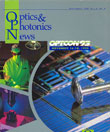
September 1993 Issue
Feature Articles
The Color Of Science
Although the number of science and engineering (S&E) degrees earned by underrepresented minorities—African Americans, Native Americans, and Hispanic Americans—continues to slowly increase, their numbers are still small. According to the National Science Foundation, the number of S&E doctorates awarded to these minorities in 1990 was 831—just 6% of all S&E doctorates. In 1980, 559, or 4% of all S&E doctorates were earned by minorities. Of 63,087 engineering degrees granted in 1991-92, 7.4% went to African Americans, Hispanics, and American Indians. The National Action Council for Minorities in Engineering (NACME) contends that two-thirds of freshmen enrolling in engineering programs never complete their programs and half of those students drop out of college altogether.
by Susan M. ReissWhat “Waves” In A Lightwave?
In this column, we have introduced experiments you can do with youngsters to help them understand a variety of light phenomena. Many of these articles have dealt with the characteristics and behavior of light, such as reflection, scattering, and color. A much more difficult question, in my opinion, is the very basic: What is light? In observing light phenomena with children, there are a lot of ways we can observe what light does. But to know what light is seems more difficult. I am not speaking so much of the wave/ particle quality, as of the simple idea of an electro-magnetic wave, and the concept of the existence of electric and magnetic fields.
by Janet ShieldsAn International “Aye” For Optical Drawing Standards
As we have talked about international standardization efforts in optics, I often get the feeling that few people believe anything will ever come of this work. This feeling is understandable, since it has taken almost 14 years to finish and adopt ISO 10110, the optical drawing standard. However, the vote is in and all nine parts that were being voted on were approved, with only one country casting a negative vote on just two parts of the standard. In all, 12 countries took part in the voting, and it is interesting to see how international the vote was. In addition to seven votes from European countries, the balance came from China, India, Japan, South Africa, and the U.S. In several cases, the countries contributed nothing to the writing of the standard, yet voted for acceptance without even making comments on it. To me, this indicates an understanding that this will be the international optical drawing standard, and that these countries have accepted this and are ready to move ahead using the new standard.
by Robert ParksTaking The Blur Out Of Autofocus Camera Mechanisms
Welcome to "Everyday Optics," a new column in Optics and Photonics News designed to provide a description of optical technology appearing in common surroundings, yet often overlooked. Patterned after the ever popular "How Things Work..." series of books, upcoming articles will look at the optical technology found in intraocular lens implants, supermarket bar-code scanners, projection TV, door peepers, and more.
by Peter CarellasManufacturing Low Cost Optoelectronic Components
Why do some products sell well while others with considerable technical merit languish? For an optoelectronic product to be successful in the marketplace, several important elements must be simultaneously achieved. First, the performance of the product must meet customer needs. Second, the product should have excellent quality and reliability. Finally, the price must be sufficiently low that customers are willing to buy the product. Selling price is determined to a major extent by the product's cost—the dollars it takes to manufacture each unit of product. This article discusses how manufacturing costs are calculated and how the issues of volume, yields, complexity, process robustness, and packaging impact cost. It is written for those who have little or no knowledge about manufacturing costs and presents easy to remember "rules of thumb" that provide considerable insight into what one must consider to achieve low production cost.
by Robert H. Weissman

![A multiplexed image of a human tonsil acquired. [NIAID] using the iterative bleaching extends multiplexity (IBEX) method.](https://opnmedia.blob.core.windows.net/$web/opn/media/images/articles/2024/0424/departments/202404-cover-web.jpg?ext=.jpg)
